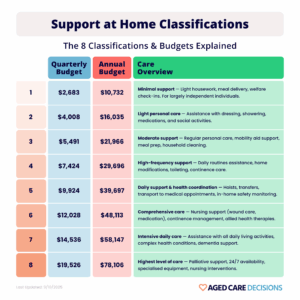
Understanding the Different Types of Aged Care
Between understanding different types of aged care, making choices about facilities, and dealing with costs, families are often faced with layers of financial paperwork and unfamiliar terminology.
Need Support? Call 1300 775 870
The Support at Home Program has replaced Home Care Packages under the new Aged Care Act from 1 November 2025.
We’re here to help you understand your options and get the support you need. Learn More.
Home Care Update – Support at Home started on Nov 1st. Learn More.
LATEST NEWS
Find the latest aged care information by browsing through our selection of important aged care information news and updates. Can’t find what you need?
Check out our Frequently Asked Questions or Contact Us to speak with our specialist team.
Filter
Categories

Between understanding different types of aged care, making choices about facilities, and dealing with costs, families are often faced with layers of financial paperwork and unfamiliar terminology.

Between understanding different types of aged care, making choices about facilities, and dealing with costs, families are often faced with layers of financial paperwork and unfamiliar terminology.

Between understanding different types of aged care, making choices about facilities, and dealing with costs, families are often faced with layers of financial paperwork and unfamiliar terminology.

Between understanding different types of aged care, making choices about facilities, and dealing with costs, families are often faced with layers of financial paperwork and unfamiliar terminology.

Between understanding different types of aged care, making choices about facilities, and dealing with costs, families are often faced with layers of financial paperwork and unfamiliar terminology.

Between understanding different types of aged care, making choices about facilities, and dealing with costs, families are often faced with layers of financial paperwork and unfamiliar terminology.

Between understanding different types of aged care, making choices about facilities, and dealing with costs, families are often faced with layers of financial paperwork and unfamiliar terminology.

Between understanding different types of aged care, making choices about facilities, and dealing with costs, families are often faced with layers of financial paperwork and unfamiliar terminology.

Between understanding different types of aged care, making choices about facilities, and dealing with costs, families are often faced with layers of financial paperwork and unfamiliar terminology.

Support at Home Classification 2 is the next step-up in community-based aged care services, aimed at individuals with low-to-moderate care needs. While Classification 1 might involve occasional visits or light assistance, Classification 2 introduces more structured and consistent care.

Support at Home Classification 1 refers to a basic or introductory level of home care assistance. It is intended for people with low-level needs, meaning they do not require intensive medical care or around-the-clock supervision, but may struggle with certain day-to-day tasks.

Whether you are just starting out with in-home support or have been receiving care for years, knowing your place within Support at Home helps you make informed choices and ensures that your needs are met.

Learn how the Support at Home program can improve your in-home care experience! This government-funded program helps you live independently longer by offering various services like nursing care and everyday assistance.

Support at Home will help more Australian seniors live at home for longer, rather than enter residential aged care. In this article we outline exactly what home care services you can spend your Support at Home package on.

This new model introduces a more flexible and personalised approach to in-home aged care, with a clear, structured framework of eight care classifications. These classifications ensure older Australians receive the precise level of care needed to remain safe, independent, and well supported at home.

Learn how the Support at Home program can improve your in-home care experience! This government-funded program helps you live independently longer by offering various services like nursing care and everyday assistance.

Learn how the Support at Home program can improve your in-home care experience! This government-funded program helps you live independently longer by offering various services like nursing care and everyday assistance.

Learn how the Support at Home program can improve your in-home care experience! This government-funded program helps you live independently longer by offering various services like nursing care and everyday assistance.

Learn how the Support at Home program can improve your in-home care experience! This government-funded program helps you live independently longer by offering various services like nursing care and everyday assistance.

Learn how the Support at Home program can improve your in-home care experience! This government-funded program helps you live independently longer by offering various services like nursing care and everyday assistance.

How to easily find and compare aged care near me in Melbourne, Sydney, Brisbane, Perth Australia
With the Support at Home Program now starting on 1 Nov 2025 and new out-of-pocket fees coming, now’s the perfect time to sign up with a provider and save on fees until 1 Nov or review your current one to ensure you’re getting the best support. Get your free list of providers and compare now.